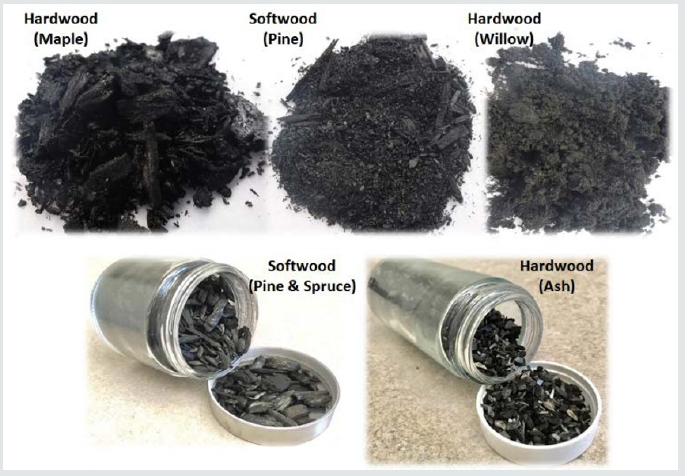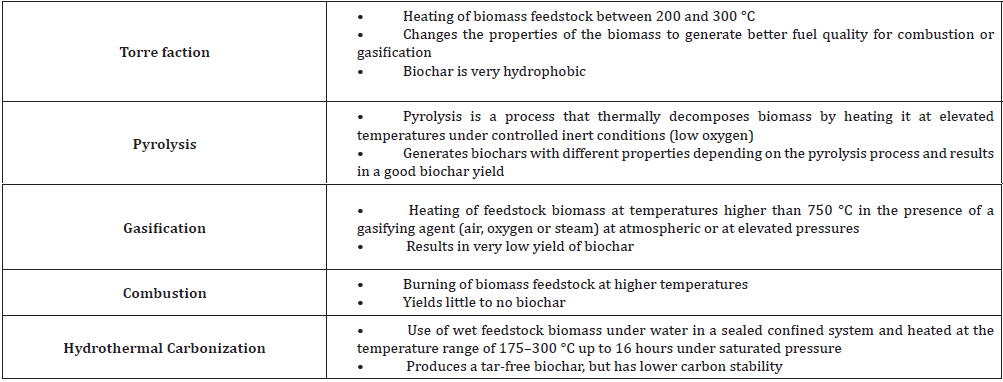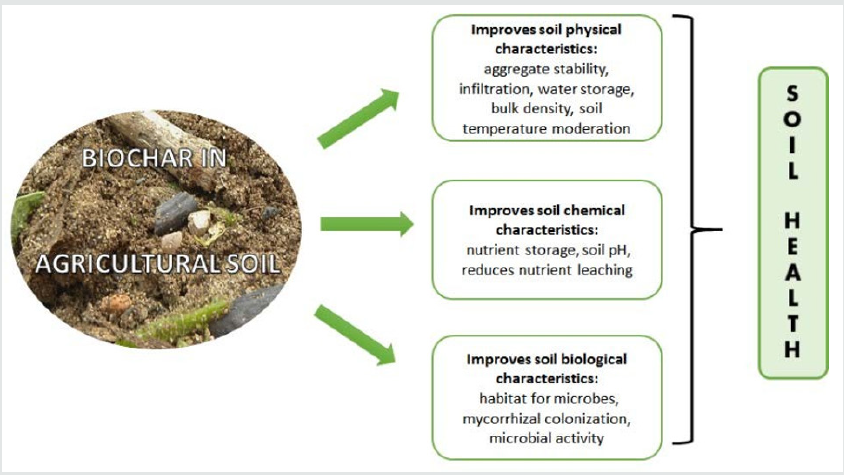
Lupine Publishers Group
Lupine Publishers
Menu
ISSN: 2641-6794
Research Article2641-6794 
Biochar and its Use in Soil: Lessons from Temperate Agriculture Volume 5 - Issue 3
Oelbermann M1*, Berruti F2 and Lévesque V3
- 1University of Waterloo, Maren
- 2Intitute for Chemicals and Fuels from Alternative Resources, Franco
- 3Agriculture and AgriFood, Canada
Received: June 10, 2020; Published: July 01, 2020
Corresponding author: Oelbermann M, University of Waterloo, Maren
DOI: 10.32474/OAJESS.2020.05.000211
Biochar Basics
What is Biochar?
Biochar is a carbon-rich product that is obtained when a sustainable source of biomass is heated without oxygen. Biochar is produced in the same way as charcoal, but their intended use differs. Biochar is manufactured with a specific set of properties (e.g. adsorption properties, ion exchange capacity, low bulk density) for its use as soil amendment and/or adsorbent, whereas charcoal has specific properties (e.g. generating heat) for its use as a fuel. Humans first used biochar in the form of charcoal (as a byproduct from cooking) mixed with broken pottery, animal bones and manure in the Brazilian Amazon. This led to the creation of the Amazonian Dark Earths or Terra Preta more than 2000 years ago by pre-Columbian cultures of this region. Whether these soils were created intentionally or if they were a by-product of human settlements remains unclear. However, Terra Preta soils are highly fertile and have demonstrated the potential for long-term carbon sequestration Figure 1. Based on this premise, researchers have encouraged the deliberate addition of biochar to tropical soils to enhance their fertility. From this work, it was found that biochar substantially improved soil properties and crop productivity, because adding biochar to nutrient-impoverished tropical soils decrease aluminum toxicity and increase soil pH, resulting in enhanced microbial activity and nutrient availability. However, temperate soils have lower iron and aluminum oxide content, a higher pH, high-activity clays, and greater soil organic matter content and will therefore respond differently to biochar than tropical soils. Amending intensively managed temperate soils with biochar is a more recent approach to agriculture, with research still in its infancy. However, a soil amendment like biochar that can maintain or improve soil health, potentially decrease fertilizer input and minimize nutrient leaching will not only place less pressure on soil resources but also contribute to environmental sustainability [1].
Figure 1: Highly leached tropical soil from the Amazon basin (a), and dark earth terra preta soil containing artefacts from Iranduba, Brazil(b).
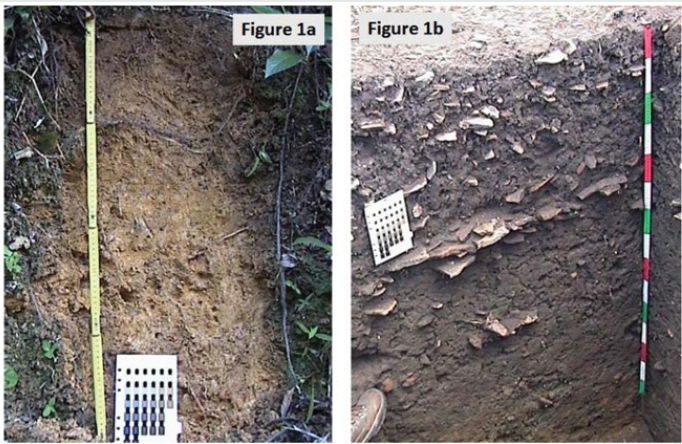
Biochar Feestocks
Biochar can be produced from a variety of feedstocks including residues from the agricultural and forest industries (straw, rice hulls, wood chips, nut shells, wood pellets, tree bark, bagasse, manure), organic waste materials and industrial by-products (food waste, paper sludge, pulp, distillers grains), purpose grown biomass (miscanthus and switchgrass), or undesirable invasive grasses (phragmites). Due to biochar’s structure, it is chemically and biologically more stable compared to the organic matter from which it is made. However, the source of the feedstock and the conditions during biochar production (pyrolysis) are major controls on the biochar’s characteristics including its carbon and ash content, pH, elemental composition, and stability Table 1. Not all biochar’s are the same, and the benefits of biochar are not universal. For example, biochar made from animal manure will have a higher nutrient content and is more likely to improve soil fertility. Biochar made from wood waste is more suited to carbon sequestration due to its greater long-term stability. Also, different soil textures will interact differently when the same type of biochar derived from the same feedstock is added Table 2. Adding the same type of biochar to the same soil type but under different climates will not result in the same outcome. Recent research shows that adding biochar in coarse and medium textured soil results in greater fertility improvement than adding biochar to heavy textured soil [2]. Biochar’s can also be engineered to have specific physical and chemical properties by selecting desired feedstock properties and pyrolysis conditions. For example, biochars can be engineered to function as a soil amendment or as a sorbent for pollutants, such as heavy metals and pesticides [1].
Table 1: Chemical characteristics of biochars dervied from various feestocks.
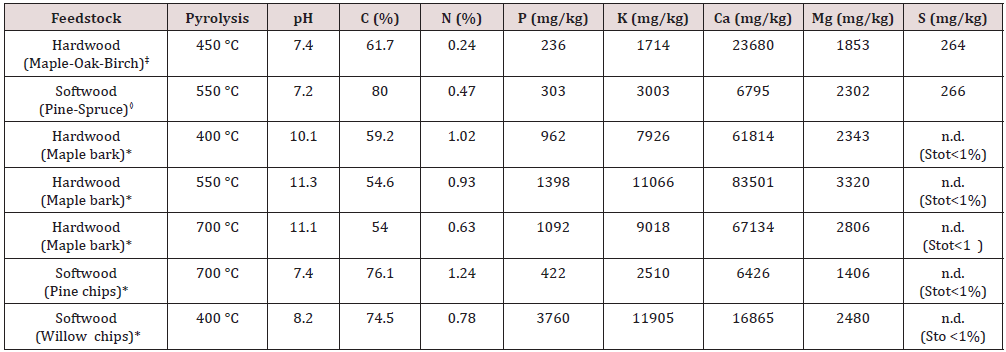
‡ Adapted from Dil, M., Oelbermann, M., Xue, W. 2014. The influence of nitrogen-enriched biochar on maize (Zea mays L.) biomass
and soil biochemical characteristics. Canadian Journal of Soil Science 94:551-562.
◊ Adapted from Mechler, M., Jiang, R., Silverthorn, T.K., Oelbermann, M. 2018. Impact of biochar on soil characteristics and
greenhouse gas emissions: a field study. Biomass & Bioenergy 118:154-162.
* Adapted from Lévesque, V., Rochette, P., Ziadi, N., Dorais, M., Antoun, H., 2018. Mitigation of CO2, CH4 and N2O emissions from
a fertigated horticultural growing medium amended with biochars and a compost. Applied Soil Ecology 126, 129–139.
Table 2: Soil chemical characteristics in soil from southern Ontario with coarse (Delhi), medium (Elora) and fine (Vineland) textures amended with 1 t/ha maple-oak-birch biochar using fast pyrolysis, 450 C.

Information adapted from Dil, M., Oelbermann, M., Xue, W. 2014. The influence of nitrogen-enriched biochar on maize (Zea mays L.) biomass and soil biochemical characteristics. Canadian Journal of Soil Science 94:551-562.
Feedstocks and Quality of Biochar
Different feedstocks have different qualities in terms of
nutrient composition, and as mentioned above, if the same
feedstock is processed under different pyrolysis processes, the
biochar produced has different characteristics. Even using the same
feedstock and pyrolysis processes can sometimes generate slight
differences in biochar characteristics. This is the case for feedstocks
derived from composted food waste. Therefore, using a high-quality
feedstock source is important in order to avoid any negative effects
on soil. Feedstock derived from contaminated sites or feedstock
containing known contaminants which have been converted to
biochar should not be added to agricultural soil. This is because
feedstock containing heavy metals (e.g. lead, zinc, arsenic) and
other contaminants will generate a low-quality biochar containing
heavy metals, polycyclic aromatic hydrocarbons, and dioxins, which
will negatively affect the soil, plants and environment.
Therefore, it is important to use biochar produced from high
quality feedstock and through a consistent pyrolysis process Figure
2. The resultant biochar should also have been characterized
(e.g. carbon, nutrient and heavy metal content). According to the
International Biochar Initiative, a high-quality biochar must contain
at least 60% carbon. Inhibition of crop germination and earthworm
avoidance can be used to test biochar safety. In addition, the use of
a suitable biochar as soil amendment should have these two criteria
of carbon (C), oxygen (O) and hydrogen (H) content according to
Schimmel pfennig and Glaser [3]: O/C ratio<0.4 and H/C ratio<0.6.
Potential Uses of Biochars
Due to its structure and composition, there are many promising applications for the biochar, such as soil amendment, food or feed additive, composite materials, activated carbon, electrodes for batteries or electrolysis cells, metallurgical coke substitute, coal substitute, catalyst for tars, pharmaceutical and cosmetic, and could be eligible for carbon credits. Nanda [4] have published an extensive review on the broad applications of biochar.
How are Biochars Made?
Several reviews have illustrated the different technologies and processes used experimentally and industrially to produce biochar [4,5]. These include Torre faction, pyrolysis, gasification, combustion, and hydrothermal carbonization Table 3. Scale and potential mobility are important considerations in relation to the feedstock supply, logistics, seasonality, further refining, products quantities, characteristics and value, and potential markets.
Torre faction involves heat treatment of biomass under
atmospheric pressure and within a temperature range of 200–300
°C, without oxygen or with limited oxygen supplies. It yields char
with less moisture, higher energy density, lower weight, lower O/C
and H/C ratio, increased hydrophobic nature and resistance to
biological degradation with respect to the original feedstock. Typical
yields of terrified biomass range between 50 and 80%. Gasification
is a thermochemical process carried out at temperatures higher
than 750 °C in the presence of a gasifying agent (typically air,
oxygen, or steam) at atmospheric or at elevated pressures. Under
these conditions, biochar yields are not sufficiently significant to
consider gasification an appropriate biochar production process.
Similarly, combustion is not a suitable biochar production process,
since, theoretically, under good combustion conditions, biochar
yield should be negligible.
Together with Torre faction, pyrolysis and hydrothermal
carbonization are the major processes used for biochar production,
whose characteristics will greatly depend upon temperature, heating
rate, residence time, feedstock type and physical characteristics, and
reactor configuration. Hydrothermal carbonization is performed
with wet feedstock biomass under water in a sealed confined
system and heated at the temperature range of 175–300 °C up to 16
h under saturated pressure under subcritical conditions producing
tar-free biochar (hydrochar) with large number of functional
groups. Hydrochars contain predominantly aliphatic compounds
and more oxygen functional groups and higher cation exchange
capacity than conventional biochar’s. On the other hand, they have
lower surface area, micro porosity, and carbon stability.
Among the various thermal technologies, pyrolysis has been the
most investigated technique and considered the best technology
to produce biochar. The various modes of pyrolysis include slow,
intermediate, fast, flash, and ultra-pyrolysis, carried out under
vacuum, atmospheric pressure or under pressure. Garcia-Nunez
[6] have published an extensive review on pyrolysis reactor
technologies. Due to the balance between primary, secondary
cracking and recombination reactions, bio-oil yields are typically
maximized (up to 70%) at intermediate temperatures (450-550
°C), faster heating rates (100-500° C/s) and short vapor residence
times (< 1~2 s), which are characteristic of fast and flash pyrolysis.
Under these conditions, biochar yields are typically of the order
of 15~20%. On the other hand, higher biochar yields (25~40
%) are achieved at moderate temperatures (300-450 °C), slower
heating rates (~ 1 °C/s) and longer vapor residence times (> 5~10
s), representative of slow or intermediate pyrolysis, when bio-oil
yields vary between 40 and 50% with the balance being gas.
The efficiency of biochar in most applications significantly
depends on its carbon and ash content, surface area, pore size
distribution, alkalinity, hydrophobicity, ion-exchange capacity, and
elemental composition. These properties are subject to variations
depending on the biochar feedstock, pyrolysis temperature,
heating rate, residence time, potential oxidation medium, pre-,
and post-processing treatments. Temperature plays a prominent
role in determining biochar quantity and quality. As the pyrolysis
temperature increases within the broad range between 300 °C and
700 °C, aromatic carbon, ash, surface area, pore volume and pH
increase, while yield, volatile matter, hydrogen and oxygen content,
conductivity and cation exchange capacity decrease. Moisture is
also reported to have certain positive impacts on biochar yield. High
moisture containing biomasses are found to improve the yield of
biochar. Studies on woody and agricultural biomass have reported
biochar yields positively correlated with the lignin content.
Surface area and pore volume are chief parameters to evaluate the
absorption by biochar, particularly for organic molecules. Although
higher processing temperatures increase the specific surface area,
high heating rates favor such increases. Therefore, biochar derived
at higher temperatures are more efficient for adsorption of organic
contaminants due to the higher surface area and pore volume,
whereas biochar generated at lower temperatures is effective for
adsorption of inorganic contaminants due to greater intensity
of O-containing functionalities and higher incidence of cationic
complexes in the soil.
Based on these considerations, the quality of the biochar is
strongly influenced by the reactor technology in which it is produced
and on its operating conditions. Although stoves can produce
biochar, its quality is highly questionable as the operating conditions
are not carefully controlled. Biochars produced in batch mode are
different than biochars produced in continuous operations. Mixing
is a critically important parameter to ensure uniform reaction
conditions and, consequently, product quality control. Mixing
strongly influences heat transfer and, therefore, heating rates of the
reacting biomass and, as discussed, product characteristics. Slow
pyrolysis is carried out in rotating kilns, intermediate pyrolysis is
auger type or mechanically mixed reactors, whereas fast pyrolysis
is carried out in fluidized, circulating fluidized beds or rotating
cone reactors.
Specific Uses of Biochar in Agriculture and Horticulture
Soil Health
Soil health is defined as the capacity of the soil to function as a living system to sustain biological productivity, maintain environmental quality and promote plant, animal, and human health [7]. The application of biochar to temperate soil has demonstrated improvement or the potential to improve a variety of soil health indicators Figure 3. Biochar can also play an important role in higher- valued horticultural crops. In the horticultural industry, peat is a favored growing medium, but due to its long regeneration time, peat is a non-renewable resource. However, research has shown that 15% (by volume) biochar can be added to peat and improve crop productivity and soil characteristics [8]. Its labile carbon content may stimulate microbial activity and interact with roots and soil bacteria, promoting plant-growth-beneficial microorganisms in peat and in soil [9-12].
The following soil health characteristics, which can also be
linked to the OMAFRA Soil Health Strategy (ahttp://www.omafra.
gov.on.ca/english/landuse/soil-strategy.pdf), have demonstrated
improvement when biochar was added to temperate soil or its use
as a horticultural growing medium Brassard [1]:
• increase water holding capacity and infiltration by adding pore
space and supporting aggregation.
• moderation of soil temperature extremes.
• soil structure through aggregation (better aggregate stability)
and crop root penetration.
• decrease in bulk density.
• increase cation exchange and nutrient storage.
• moderation of soil acidity.
• changes in microbial community composition and substrate
utilization.
• increase microbial activity and diversity.
• increase mycorrhizal fungal colonization.
• increase nitrogen fixation.
• promote beneficial microorganisms for plant growth.
• reduce greenhouse gas emissions.
Crop Productivity
A recent survey evaluated 1000 different research studies on the effect of biochar on crop yield. Although biochar showed favorable results on crop productivity, with a 25% increase in yield, in tropical environments this effect was not observed under temperate conditions. This confirmed that biochar benefits tropical soils but biochar application to the more fertile temperate soils and its effect on crop yield remains uncertain [13]. Low yield responses due to biochar addition have been observed on fertile soils and in some cases low rates of biochar addition did not result in crop productivity. A field study from southern Ontario Figure 4 did not find a significant improvement in corn or soybean production when biochar, derived from pine and spruce wood waste, was added at 3 t/ha and combined with poultry manure [14]. The same study also found that the ratio of shoot to root biomass (shoot/root ratio) for corn or soybeans was lower when soil was amended with biochar. This suggested that crops produced with biochar experienced lower environmental stress (e.g. water stress) than those produced without biochar. Most researchers concur that use of a highquality biochar in temperate soil, although it may not improve crop yield, will have no negative effects on crop productivity, but will improve soil health. The application of biochar in legumebased intercropping system with cereal crop might be beneficial for improving cereal growth and reducing N fertilizer supply. According to the study of Liu [15] the intercropping maize with peanut system with biochar amendment allowed a higher nodule weight on peanut roots promoting a better N fixation, favoring thereby a higher N transfer from peanut to maize. There is currently no information on the effects of biochar on pasture production.
Figure 4: Soybean and maize grain yield in a loamy-textures soil amended with 6 t/ha poultry manure plus 150 kg/ha N fertilizer (MN), or t/ha poultry manure plus 3 t/ha biochar (MB) or 3t/ha poultry manure, 3 t/ha biochar,150 kg/ha N fertilizer (MNB) in southern Ontario. Data provided by T. Silverthorn.
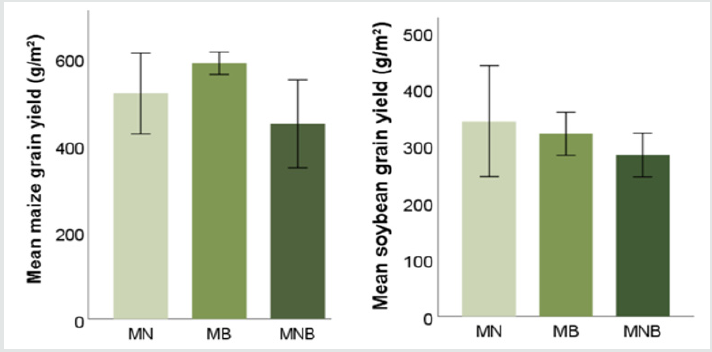
Nutrient Leaching and Crop Nutrient Uptake
Biochar has the ability to retain soil nutrients such as ammonium, nitrate and phosphorus, and this effect is most readily observed in light-textured (e.g. sandy) soils. This provides an opportunity for increased nutrient uptake and reduced leaching of nutrients applied by fertilizers from entering local water sources (e.g. Ontario Great Lakes Strategy Priority: https://www.ontario. ca/page/ontarios-great-lakes- strategy). Some research has suggested that the ability of biochar to adsorb nutrients could result in lower fertilizer requirements; studies are currently underway to assess this component. A laboratory study found that adding low quantity of biochar (1 t/ha) combined with urea ammonium nitrate enhanced corn nitrogen uptake in a coarse-textured soil Table 2. This study also found a higher nitrogen utilization efficiency in fine-textured soil, suggesting that biochar could serve as a carrier for nitrogen [15]. The size of the biochar particles also influences nutrient leaching potential. Typically, large (2 to 4 mm) or medium (1 to 2 mm) biochar particles have a better capacity to adsorb nutrients and prevent them from leaching, whereas small and very vine (0.05 to 1 mm) biochar particles are subject to greater movement in soil and can facilitate the transport of nutrients and other agrochemicals like herbicides [16].
Some studies showed that the presence of biochar reduced phytotoxicity of herbicide residues such as atrazine. However, due to the high-binding capacity of some biochars, it could also render herbicides inactive and make them less effective in controlling weeds. Biochar with a high specific surface area, high micro porosity and highly aromatic carbon influences the persistence, release, and bioavailability of herbicides [17]. Further work on this is currently underway.
Greenhouse Gases
Currently, only a few field studies have evaluated temporal changes in greenhouse gas emissions in soil amended with biochar; and these studies found variable results. For carbon dioxide (CO2) and nitrous oxide (N2O), studies conducted under field conditions reported no effect of biochar on CO2 emissions [18]. A 3-year study from southern Ontario found no difference in CO2 and N2O emissions from soil amended with biochar (3 t/ha), poultry manure and/or nitrogen fertilizer compared to soil without biochar [14]. However, greenhouse gas emissions, particularly N2O, from biochar amended soil are also dependent upon the type of biochar used, based on feedstock type and pyrolysis processes, its addition rate, agricultural management practices, and variation in climate depending on the location of the site. There is also some evidence that the impact of biochar on N2O emissions can change over time as the biochar ages. Ageing of biochar can decrease N2O emissions with time due to stabilization of carbon and nitrogen. However, the use of biochar in mitigating greenhouse gases can also be integrated with Canada’s Climate Change Mitigation Strategies ( https://www.canada.ca/en/ services/environment/weather/climatechange.html).
Carbon Sequestration and Biochar Stability in Soil
Soil carbon sequestration, also known as carbon farming or regenerative agriculture includes various ways of land management practices that encourage the long-term storage of carbon. Increasing carbon in soil can be achieved when the rate of addition of organic matter is greater than its rate of decomposition in soil. Biochar has a molecular structure that makes it more resistant to microbial decomposition, compared to non-pyrolyzed organic matter (e.g. crop residues, manure, cover crops), allowing it to persist in soil for 1000 to 10,0000 years. Biochar contributes to carbon stabilization by promoting aggregate stability and through its association with organo-mineral complexes. Some researchers have speculated that the presence of aged biochar reduces decomposition rates of crop- derived residue carbon in soil and increases crop residue stabilization in soil aggregates [19]. In southern Ontario, a 3-year study did not find an increase in soil organic carbon when biochar was added to soil [14]. This is because measurable changes in soil organic carbon are difficult to detect over the short-term (<10 years), and variation among years have been observed since the soil is not in equilibrium. However, the field study from southern Ontario found a greater concentration of extractable carbon in soil amended with biochar, indicating that a readily available carbon source for the microbial community was present. This suggests that a greater accumulation of decomposing organic matter was likely derived from the biochar and/or its interaction with soil organic carbon and crop roots.
The stability of biochar applied to soil depends on the biochar’s properties and soil mineralogical composition. Evaluating the impact of biochar on soil carbon sequestration and stabilization is difficult since most of these changes are not readily observed over the short-term. Simulation models, if calibrated to the study site’s environmental conditions (e.g. climate, soil characteristics) and land management practices can provide insight into the potential longterm effect of biochar on soil carbon. For example, Dil & Oelbermann [2] simulated the effect of biochar addition on soil organic carbon stocks over 150 years based on soil collected in southern Ontario from Elora (medium texture), Delhi (coarse texture) and Vineland (fine texture). Using the century soil organic matter model, they found that a once application of maple-oak-birch derived biochar at 2 t/ha, compared to other management practices including maizesoybean rotation, continuous maize, addition of manure, and no till, led to a greater increase and long- term stabilization of soil organic carbon at the Elora and Delhi sites. They also found that the quantity of carbon stabilized was influenced by the soil texture, and soil texture also influenced whether carbon was stabilized in active, slow, or passive carbon fractions.
Other Uses of Biochar in Agriculture
Recently, the use of biochar as a livestock feed supplement has also received some interest from the agricultural community. The benefits of biochar as a feed supplement may influence animal health for gastrointestinal decontamination and nutrition. Some studies have shown an improvement in production and livestock health. There has also been some research into using biochar to help reduce ruminant methane production. In southern Ontario, University of Guelph’s Dr. A. Carpenter (Ridgetown campus) is investigating various aspects of biochar as a feed supplement in dairy cows.
Some Precautions
Biochar Storage and Handling
Biochar can form explosive mixtures with air in confined spaces. There is also a danger of spontaneous heating and ignition when biochar is tightly packed. Fresh biochar quickly adsorbs oxygen and moisture, which can lead to high temperatures and ignition. Volatile compounds in biochar can also present a fire hazard, which is more of a concern for low quality biochar. When biochar is mixed with other amendments such as manure or composts, its potential to become flammable is greatly reduced.
Incorporation of Biochar with Soil
Depending on the feedstock and the process used to generate
biochar, the resultant product can take on many forms ranging
from coarse to powdered material. Researchers suggest that it
is important to retain a coarser structure of the biochar as this
maintains its ability to hold water, nutrients and encourages
microbial activity. If biochar is incorporated into the soil as a powder
(less than 50 microns in size), then its capacity to hold water and
nutrients are lost. However, biochars can also be generated for a
specific purpose e.g. enhanced nutrient adsorption.
Uniform topsoil mixing can be achieved by mechanically
applying biochar using a spreader and then mixing it into the
soil by ploughing or disking. When mixing biochar with other
amendments, the same approach of uniform topsoil mixing can be
used. In certain management systems e.g. orchards or vineyards,
the biochar is mixed with the other amendment(s) and top dressed
between rows of trees or vines. Incorporation biochar with liquid
manures can be done when the biochar is applied to the soil surface
in a uniform layer or incorporated into the soil. This can, however,
cause blockages of flow if biochar particles are large or a high
quantity of biochar is used. Therefore, testing of viscosity and flow
of the biochar-liquid manure mixture is recommended prior to its
application at the field scale. Deep- banding of biochar allows for
the placement of the biochar directly into the rhizosphere of the
crop and reduces risk of biochar loss via erosion. Top dressing
biochar is a desirable approach in no-till systems. However, with
top dressing there is a risk of water and wind erosion, especially if
biochar particles have a fine texture. This can be avoided if biochar
is mixed with moist manure.
Application Rates and Combination with Other Amendments
The optimal rate of biochar application to agricultural soil has
not yet been established. Average application rates ranged from
as low as 3 t/ha to 50 t/ha. Optimal rates will depend on biochar
type, soil characteristics and management objectives. To date,
the majority of studies that evaluated the impact of biochar on
temperate soil have added large quantities of biochar (10 t/ha),
but this may also not be a cost- effective approach to produce field
crops. However, the horticultral industry that produces high-value
vegetable crops, the use of biochar as a growing medium may be a
more cost-effective approach compared to currently used growing
media [8].
For field crops, researchers are in agreement that adding only
biochar to temperate agricultural soil will likely result in a minimal,
if any, improvement especially in fine-textured (clay) soil. Instead,
biochar is more effective when mixed with other soil amendments
such as solid or liquid manure, compost and/or fertilizers [20].
This will improve the efficiency of the biochar and the other
amendment(s) than when applied alone. Adding biochar also
reduces the odor of some manures [21,22]. Biochar can be applied
as a single application which can provide benefits for several years
due to its recalcitrance. Since biochar ages in soil and its interaction
with soil changes with time, it is not necessary to apply biochar at
each crop seeding. However, field data is currently not available if it
is more effective to apply a large dose of biochar at once, or if yearly
applications at lower rates is more desirable.
Next Steps: How to Integrate Biochar on Your Farm
The performance and stability of biochar in soil are highly dependent on soil types, plant species, and climate. Growers interested in using biochar on their property should apply it to a small area of their farm and then monitor results in subsequent years. Several key points should be kept in mind when considering the use of biochar as a soil amendment:
• soil texture and fertility;
• nutritional requirements of the plant;
• local climate;
• feedstock quality and pyrolysis process;
• biochar particle size;
• which other amendments will the biochar be mixed with: mineral fertilizer, manure, or other types of organic amendments such as compost;
• what is the objective of using biochar: nutrient retention, improved soil health, carbon sequestration and/or greenhouse gas reduction, etc. For example, biochar used for carbon sequestration should be derived from wood feedstock (highcarbon source) produced at high pyrolysis temperatures for long-term stability. Using biochar with the intended use of increasing soil health/fertility should be derived from a feedstock with a greater nutrient content such as manure. It is recommended that available nutrients, rather than total nutrients, in the biochar should be measured.
Where to obtain biochar?
There is an increasing interest in integrating biochar and
biochar-products in agriculture. However, logistical difficulties
in obtaining biochar and the current high costs of biochar, since
it is still mostly an experimental product, have led to some smallscale
on-site pyrolysis projects. Although do-it-yourself biochar
production may be more cost effective, there are some potential
problems with this approach:
• lack of controlled pyrolysis conditions that result in biochar
with variable characteristics and therefore an inconsistent
product.
• inability to capture toxic and/or greenhouse gases produced
during pyrolysis;
• contamination of feedstock with heavy metals;
• lack of biochar characterization.
• Although biochar obtained from external sources is more
expensive, there are several advantages when using biochar
derived from an established and reputable producer:
• availability of biochar from different and high-quality feed
stocks;
• consistent and high quality biochar;
• characterization of biochar’s attributes;
• Capture of gases produced during pyrolysis.
As the biochar market continues to advance, including
the development of cost-effective mobile units that reduce
transportation costs, applications at the farm-scale will become
more economical in time.
Acknowledgements
This work was generously supported by the Ontario Ministry of Agriculture, Food and Rural Affairs (OMAFRA). We also thank the University of Waterloo and the Canadian Foundation for Innovation for providing infrastructure support. Grauduate students were supported by OMAFRA, Ontario Graduate Scholarship (OGS) and the Natural Sciences and Engineering Research Council (NSERC). We thank H&N Baker Farms for supporting our field work and providing the field site that contributed to the completion of this document.
References
- Brassard P, Godbout S, Lévesque V, Palacios JH, Raghavan V, and et al., (2019) Biochar for soil amendment. In Jeguirim M, Limousy L (Eds.), Char and Carbon Materials Derived from Biomass. Production, characterization, and applications. Elsevier, Netherlands Pp. 109-148.
- Dil M, Oelbermann M (2014) Evaluating the long-term effects of nitrogen-enriched biochar on soil organic carbon and nitrogen using the Century model. In: Oelbermann, M. Sustainable Agroecosystems in Climate Change Mitigation. Wageningen Academic Publishers, Netherlands, pp. 249-268.
- Schimmelpfennig S, Glaser B (2012) One step forward toward characterization: Some important material properties to distinguish biochars. (Special Issue: environmental benefits of biochar.). Journal of Environmental Quality 41(4): 1001-1013.
- Nanda S, Dalai AK, Berruti F, Kozinski JA (2016) Biochar as an exceptional bioresource for energy, agronomy, carbon sequestration, activated carbon and specialty materials, Waste Biomass Valorization 7: 201-235.
- Meyer S, Glaser B, Quicker P (2011) Technical, economical, and climate-related aspects of biochar production technologies: a literature review. Environ Sci Technol 45(22): 9473-9483.
- Garcia-Nunez JA, Pelaez-Samaniego MR, Garcia-Perez ME, Fonts I, Abrego J, and et al., (2017) Historical Developments of Pyrolysis Reactors: A Review 31(6): 5751-5775.
- Doran JW, Zeiss MR (2000) Soil health and sustainability: managing the biotic componet of soil quality. Applied Soil Ecology 15(1): 3-11.
- Lévesque V, Rochette P, Ziadi N, Dorais M, Antoun H (2018) Mitigation of CO2, CH4 and N2O from a fertigated horticultural growing medium amended with biochars and a compost. Applied Soil Ecology 126: 129-139.
- Cheng N, Peng Y, Kong Y, Li J, Sun C (2018) Combined effects of biochar addition and nitrogen fertilizer reduction on the rhizosphere metabolomics of maize (Zea mays L.) seedlings. Plant and Soil 433: 19-35.
- Jaiswal A, Elad Y, Paudel I, Graber ER, Cytryn E, and et al., (2017) Linking the belowground microbial composition, diversity, and activity to soilborne disease suppression and growth promotion of tomato amended with biochar. Scientific Reports 7: 44382.
- Kolton M, Harel YM, Pasternak Z, Graber ER, Elad Y, et al., (2011) Impact of biochar application to soil on the root-associated bacterial community structure of fully developed greenhouse pepper plants. Applied and Environmental Microbiology 77(14): 4924-4930.
- Kolton M, Graber ER, Tsehansky L, Elad Y, Cytryn E (2017) Biochar-stimulated plant performance is strongly linked to microbial diversity and metabolic potential in the rhizosphere. New Phytologist 213(3): 1393-1404.
- Jeffrey S, Abalos D, Prodana M, Bastos AC, van Groeninen JW, et al., (2017) Biochar boosts tropical but not temperate crop yields. Environmental Research Letters 12(5): 1-7.
- Mechler M, Jiang R, Silverthorn TK, Oelbermann M (2018) Impact of biochar on soil characteristics and greenhouse gas emissions: a field study. Biomass & Bioenergy 118: 154-162.
- Liu L, Wang Y, Yan X, Li J, Jiao N, and et al., (2017) Biochar amendments increase the yield advantage of legume-based intercropping systems over monoculture. Agriculture, Ecosystems and Environment 237: 16-23.
- Verheijen FGA, Zhuravel A, Silva C, Amaro A, Ben-Hur M, and et al., (2019) The influence of biochar particle size and concentration on bulk density and maximum water holding capacity of sandy versus sandy loam soil in a column experiment. Geoderma 347: 194-202.
- Mendes-Ferreira K, Junior-Dias AF, Takeshita V, Rego APJ, Tornisielo VL (2018) Effect of biochar amendments on the sorption and desorption of herbicides in agricultural soil.
- Fidel RB, Laird DA, Parkin TB (2019) Effect of biochar on soil greenhouse gas emissions at the laboratory and field scales. Soil Systems 3(8): 1-12.
- Hernandez-Soriano MC, Kerr B, Goos P, Hardy B, Dufey J, and et al., (2016) Long-term effect of biochar on the stabilization of recent carbon: soils with historical inputs of charcoal. Global Change Biology Bioenergy 8(2): 371-381.
- Belcher RW, Jarand ML (2017) Biochars for use in composting, US.
- Lehmann J, Joseph S (2015) Biochar for environmental management: science and technology. (2ndedn), Routledge.
- Glaser B, Haumaier L, Guggenberger G, Zech W (2001) The “Terra Preta” phenomenon: A model for sustainable agriculture in the humid tropics. Naturwissenschaften 88(1): 37-41.

Top Editors
-

Mark E Smith
Bio chemistry
University of Texas Medical Branch, USA -

Lawrence A Presley
Department of Criminal Justice
Liberty University, USA -

Thomas W Miller
Department of Psychiatry
University of Kentucky, USA -

Gjumrakch Aliev
Department of Medicine
Gally International Biomedical Research & Consulting LLC, USA -

Christopher Bryant
Department of Urbanisation and Agricultural
Montreal university, USA -

Robert William Frare
Oral & Maxillofacial Pathology
New York University, USA -

Rudolph Modesto Navari
Gastroenterology and Hepatology
University of Alabama, UK -

Andrew Hague
Department of Medicine
Universities of Bradford, UK -

George Gregory Buttigieg
Maltese College of Obstetrics and Gynaecology, Europe -

Chen-Hsiung Yeh
Oncology
Circulogene Theranostics, England -
.png)
Emilio Bucio-Carrillo
Radiation Chemistry
National University of Mexico, USA -
.jpg)
Casey J Grenier
Analytical Chemistry
Wentworth Institute of Technology, USA -
Hany Atalah
Minimally Invasive Surgery
Mercer University school of Medicine, USA -

Abu-Hussein Muhamad
Pediatric Dentistry
University of Athens , Greece

The annual scholar awards from Lupine Publishers honor a selected number Read More...




